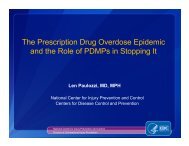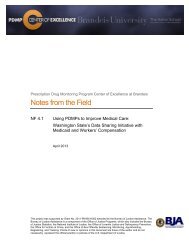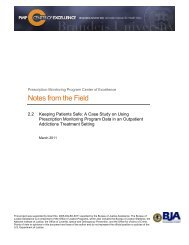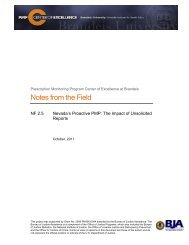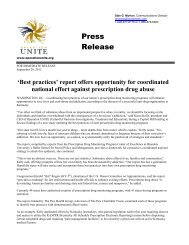Prescription Drug Monitoring Programs - PDMP Center of Excellence
Prescription Drug Monitoring Programs - PDMP Center of Excellence
Prescription Drug Monitoring Programs - PDMP Center of Excellence
You also want an ePaper? Increase the reach of your titles
YUMPU automatically turns print PDFs into web optimized ePapers that Google loves.
<strong>Prescription</strong> <strong>Drug</strong> <strong>Monitoring</strong> <strong>Programs</strong>: An Assessment <strong>of</strong> the Evidence for Best Practices 34Assistance <strong>Center</strong> and the <strong>PDMP</strong> COE. A survey <strong>of</strong> <strong>PDMP</strong> practices in this area would help identifyeffective approaches to public education and the sorts <strong>of</strong> reports and analyses that are appropriate forrelease and most influential in increasing <strong>PDMP</strong> awareness.Current adoption status: States vary to the extent to which they proactively disseminate findings andoutcomes related to <strong>PDMP</strong> data and activities to the wider public. A majority <strong>of</strong> <strong>PDMP</strong>s have websites(list available at www.pmpalliance.org/content/state-‐pmp-‐websites) that give an overview <strong>of</strong> programobjectives and operations but are largely configured to accommodate authorized <strong>PDMP</strong> users. However,a few programs also make data analyses available. For example, Maine <strong>of</strong>fers recent <strong>PDMP</strong> news and anepidemiological evaluation <strong>of</strong> <strong>PDMP</strong> data from 2005 to 2008(www.maine.gov/dhhs/samhs/osa/data/pmp/index.htm), and Virginia posts reports showing increased<strong>PDMP</strong> utilization and concomitant declines in doctor shopping rates(www.dhp.virginia.gov/dhp_programs/pmp/docs/ProgramStats/2010PMPStatsDec2010.pdf). Others,such as Kentucky, link to satisfaction surveys that document the valuable role <strong>PDMP</strong>s play in clinicalpractice, and to regular (e.g., quarterly) reports that show prescribing patterns by geographic area, forinstance the mostly widely prescribed drugs in each county.Barriers to adoption: Barriers to publicizing <strong>PDMP</strong> data and activities include resource limitations ingenerating data analyses, disseminating reports, and in expanding, updating, and maintaining websites.SummaryRationale: Raising awareness <strong>of</strong> <strong>PDMP</strong>s via websites, presentations, and reports may help build supportand help ensure funding.Evidence <strong>of</strong> effectiveness: Accumulated experience, key stakeholder perceptions.Current adoption status: Some <strong>PDMP</strong>s publicize findings via data summaries and reports via publicwebsites and other outlets.Barriers to adoption: Lack <strong>of</strong> staff resources to produce and disseminate reports, maintain websites.<strong>PDMP</strong> recruitment, utilization, and educationBest practices in recruitment, utilization, and education will maximize participation in a <strong>PDMP</strong> by allappropriate users. They will also promote understanding the value and application <strong>of</strong> <strong>PDMP</strong> data inprescribing and dispensing, drug diversion investigations, drug abuse prevention programs, planning andsiting drug treatment programs and <strong>of</strong>fice-‐based opioid treatment; and other activities that addressprescription drug abuse. Candidate practices include actions to:A. Enable access to <strong>PDMP</strong> data by all appropriate users; encourage innovative applicationsB. Outreach and recruitment strategies1. Proactively identify and conduct outreach to potential high-‐impact users2. Conduct recruitment campaigns3. Streamline certification and enrollment processing



